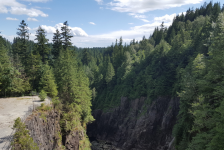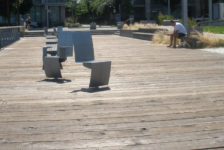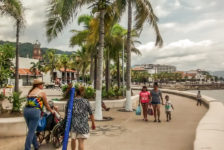At the 2014 American Society of Landscape Architects (ASLA) Annual Meeting in Denver, a group of landscape architecture practitioners and academics convened a rousing panel entitled Social Justice: The New Green Infrastructure. Moderated by Kathleen King (Design Workshop), the panel included Ann Whiston Spirn (MIT), Randy Hester (UC Berkeley), Diane Jones Allen (DesignJones), and Kurt Culbertson (Design Workshop). Culbertson was the impetus for the session focused on the need for social, economic and environmental equity to be considered as a key element of the design process. He felt this had not been adequately addressed by the profession, and that more needed to be done by planners and designers to empower affected communities. Others have written about this remarkable session and its boisterous reception (which included cheers from the audience and a spontaneous call to action for the profession to more meaningfully engage diverse populations to realize just and equitable design outcomes). King says, “Moderating this panel made me feel proud of our profession – the enthusiasm from the standing-room-only crowd was incredibly inspiring. It helped me realize that this topic isn’t just on the minds of a few interested parties but is at the heart of what we do and an extremely important part of our work’s contribution to the environment.”
 Greeley, Colorado Parks System Master Plan Work Session with Area Youth. (Design Workshop)
Greeley, Colorado Parks System Master Plan Work Session with Area Youth. (Design Workshop)
Significantly, this groundswell around community-engaged design did not recede after the conference. Within a couple months of the session, well over the 75 required ASLA member signatures had been collected to establish a new ASLA Professional Practice Network (PPN). Co-Chaired by King and Iowa State University Assistant Professor Julie Stevens, the Environmental Justice PPN launched at the 2015 ASLA Annual Meeting in Chicago, and since then the 145-member group has gathered for regular phone conferences to discuss principles, actions and resources for moving the profession forward.
The ASLA Environmental Justice PPN is now in the process of assembling a collection of precedents, approaches and tools for community-engaged design. “One of the first questions we all asked each other at the launch of the PPN was, ‘What does environmental justice look like?’” said PPN Co-Chair, Kathleen King. Under the direction of Co-Chair Julie Stevens, Iowa State University landscape architecture students are endeavoring to build a library of examples housed on a new Environmental Justice + Landscape Architecture website to serve as a venue for discussion and a research resource for the profession.
Community Work Session for Lafayette Central Park (Horse Farm), Lafayette, LA. (Franklin Associates, LLC)
At ASLA 2015, an expanded number of sessions emphasized designing for and collaborating with underserved populations to ensure that design investments deliver benefit equitably. These sessions included Designing with the Homeless which focused on engaging homeless populations as clients in a participatory design process; Measuring Environmental Justice which established a working definition of environmental justice for the design professions; and The Landscape of Gentrification, which addressed the question of whether the work of landscape architects to revitalize urban neighborhoods was contributing to gentrification. One of the ongoing roles of the Environmental Justice PPN is to ensure that the cohort of accepted sessions at each annual meeting includes content that will appeal to its members. This fall at the 2016 ASLA conference in New Orleans, the schedule includes eight sessions related to community-engaged design, including Shifting the Discussion from Gentrification to Poverty: The Role of Designers; The Politics of Landscape: An International Perspective on Environmental Justice; and Building a Diverse Community: Increasing African-American Representation in Landscape Architecture. And one of the two General Sessions, Designing for Diversity/Diversity in Design, will focus on urban demographic shifts and the need to accommodate the needs of diverse populations. The trajectory is clear: there is a surge of conversations among landscape architects about the complex social contexts of our work and the role of the designer in establishing inclusive processes to affect positive change equitably.
It is notable that many of the declarations at the Landscape Architecture Foundation’s (LAF) June 2016 Summit on Landscape Architecture and the Future focused on issues of equity and diversity. Covered in a recent Land8 article, the event was convened to celebrate the organization’s first half-century, critically reflect on what landscape architecture has achieved, and to envision the next 50 years. Declarations called for the landscape architecture profession to be leaders in addressing racial, social and economic disparities in the context of design work. UC Berkeley Professor Emeritus Randy Hester’s Declaration of Interdependence entreated designers to engage a broad range of citizens in design dialogues to ensure those who have innate knowledge of their communities are part of decision-making processes. Hester has been a vital model for the profession for his entire career focused on community shaping by diverse constituencies rather than by designers who know best. Sasaki’s Gina Ford delivered a declaration focused on Landscape Humanism that called for more diversity in the design professions to better reflect the demographics of the communities impacted by our design proposals.
 Taylor, Texas Downtown Master Plan Community Engagement. (Brent Humphries Photography, 2015)
Taylor, Texas Downtown Master Plan Community Engagement. (Brent Humphries Photography, 2015)
These conversations are not only taking place at professional conferences. In May of 2016, The National Endowment for the Arts (NEA) and the Surdna Foundation cohosted the Designing Equity forum facilitated by Toni L. Griffin, Founding Director of the J. Max Bond Center on Design for the Just City at City College of New York. The session gathered planners, designers, funding organizations and community leaders to “push forward the conversation about community engaged design in order to gain clarity about what exemplary practice, partnership, and funding looks like.” The 2015 Black in Design Conference was conceived of and convened by the African American Student Union of the Harvard Graduate School of Design (GSD) to “address social injustice through design” and pursue “just and equitable spaces across all scales.” Studios in design and planning schools are also addressing social issues. Notably, the GSD studio, The MLK Way: Building on Black America’s Main Street at the GSD led by Assistant Professor Daniel D’Oca in 2015 examined streets named after the revered Martin Luther King, Jr. Focusing on Martin Luther King Boulevard in St. Louis, the students listened to and collaborated with residents and business owners to propose solutions to inequity, disinvestment, poverty and racial segregation—unfortunately familiar conditions for neighborhoods that border MLK streets.
 Lafitte Greenway Public Workshop, New Orleans, Louisiana. (Design Workshop)
Lafitte Greenway Public Workshop, New Orleans, Louisiana. (Design Workshop)
But how are social outcomes of planning and design projects evaluated? What can be measured to truly know that a design has delivered benefits related to social equity? The Landscape Architecture Foundation’s (LAF) Landscape Performance Series includes a collection of over 100 case studies evaluating the landscape performance of built projects. The list of potential social performance benefits includes: recreational and social value, cultural preservation, health and wellbeing, safety, educational value, noise mitigation, food production, scenic quality and views, transportation, and access and equity. Access and Equity was added in 2014 to relate to social equity and underserved groups. To date, just one project comes up in a search of the case studies using this as a filter because the performance benefit categories are only assigned to projects that have a quantified benefit in that category. However, LAF Director of Programs and Communications Heather Whitlow says, “The LPS also has a Social Equity tag that culls projects in the collection designed to address these issues, whether or not there is a quantified benefit. These include parks in park-poor or underserved communities and projects with a specific goal to be inclusive.” It is LAF’s hope that the Access and Equity filter and Social Equity tag will spur more projects with these types of intentions and outcomes to apply to the performance measurement program. “While impacts related to social equity are some of the hardest to quantify and we still struggle to come up with post-occupancy metrics that prove a space with social equity aims is indeed performing,” Whitlow says. “LAF felt that this was an essential category to include in our Landscape Performance Benefits. By encouraging designers, agencies, developers and others to set measurable goals and evaluate performance related to equity and access, we ensure that these aspects are considered.”
Kurt Culbertson of Design Workshop addressed the question of how to measure environmental justice in the previously mentioned 2015 ASLA session, Measuring Environmental Justice, proposing a list of metrics for the profession to gauge its projects. These topics include: Proximity to environmental hazards, proximity to pollution, access to parks and open space (including nature and the public realm), access to transportation, access to public process, equity of public expenditure, and displacement and gentrification.
 Lafitte Greenway Public Workshop, New Orleans, Louisiana. (Design Workshop)
Lafitte Greenway Public Workshop, New Orleans, Louisiana. (Design Workshop)
This short piece in no way covers the multitude of conversations, programs and outcomes about designing just and equitable places. It surely overlooks the longstanding efforts of landscape architects and community leaders across the country to collaborate meaningfully with diverse stakeholders so that design proposals can address complex social issues. It doesn’t report on the programs of state and federal agencies, such as Environmental Protection Agency and Centers for Disease Control and Prevention, which have environmental justice guidelines in place to ensure fair treatment of all groups of people related to environmental and public health programs and policies. This simply is a series of observations about an elevated level of focus on topics of equity in community-engaged design.
Designers have a lot to learn about communities more diverse than ours and about design parity. The groundswell of conversations at ASLA and elsewhere is helping landscape architects to listen, see, understand, and collaborate to implement the design needs of overburdened and underserved communities.
Great Outdoors Colorado Plug into Nature Pilot Project—Finding Connections for Families and Youth in Larimer County, Colorado. (Design Workshop)
Published in Blog









Jasmine Davis
Before I do my own research, do you know off-hand if the Canadian SLA has a network that focuses on community-engaged design? I’m really interested in being involved in these kinds of conversations in the future, so I loved this article. Thanks! 🙂
Allyson Mendenhall
I do not know any Canadian-specific networks focused on community-engaged design, but I will check with colleagues and post if I learn of any. Thanks for your interest.